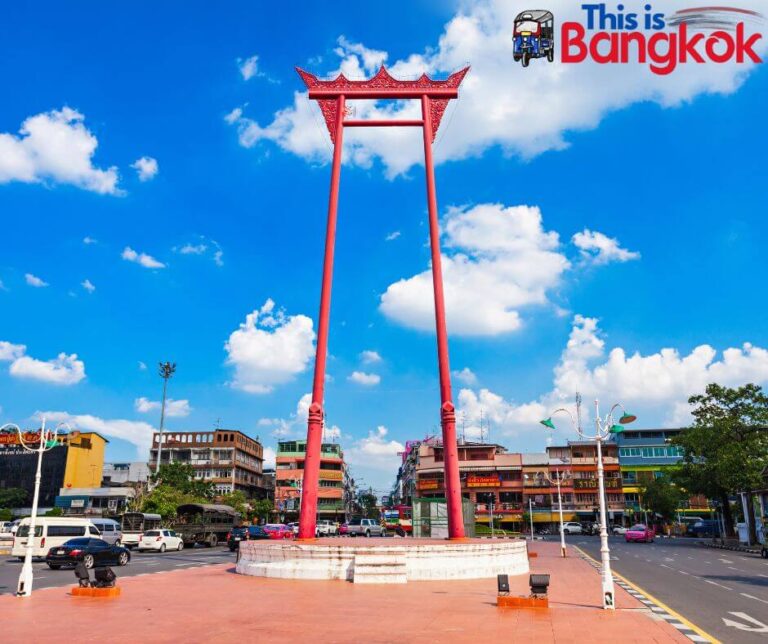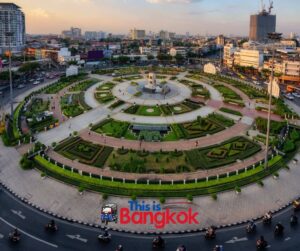The Giant Swing
The Giant Swing, also known as “Sao Ching Cha” (Sao Chingcha) in Thai, is a historic and iconic landmark in Bangkok, Thailand.
It is a prominent attraction with religious and cultural significance in the city.
Structure
The Giant Swing is a tall wooden structure with four towering red pillars.
The swing is a large red frame suspended by ropes from the top of the pillars.
The entire structure is approximately 27 meters (88.5 feet) in height.
History
The Giant Swing has a long history dating back to the reign of King Rama I in the late 18th century.
It was initially used in a Brahmin religious ceremony known as the “Triyampawai” or “Swing Ceremony” to honor the Hindu god Shiva.
Religious Significance
The swing ceremony was considered a tribute to Lord Shiva and was performed during the traditional Thai New Year (Songkran) celebrations.
It was believed that by swinging high, participants could reach closer to the heavens and make offerings to the gods for a prosperous harvest.
Relocation
The original Giant Swing was made of teakwood and stood at the front of the Devasathan Shrine in Bangkok.
However, it was dismantled and replaced with a replica in 2007 due to safety concerns and maintenance issues.
The original swing can now be found in the Bangkok National Museum.
Cultural Heritage
The Giant Swing is a religious symbol and a cultural landmark reflecting Thailand’s rich history and traditions.
Visitors often admire its intricate design and take photos of this iconic structure.
Accessibility
The Giant Swing is located in the heart of Bangkok, near Wat Suthat Thepwararam Ratchaworamahawihan, a historic Buddhist temple.
It’s easily accessible by public transportation, including buses and tuk-tuks, and is within walking distance of other popular attractions like the Grand Palace and Wat Pho.
Visitors to the Giant Swing can explore the surrounding area, visit the nearby temples, and learn more about this iconic structure’s cultural and religious significance.
It’s also a popular spot for tourists to take photographs and immerse themselves in Bangkok’s rich cultural heritage.

| Location | Bangkok, Thailand |
|---|---|
| Height | Approximately 27 meters (88.5 feet) |
| History | 18th-century landmark, used in a Hindu religious ceremony |
| Religious Significance | Honors the god Shiva, used in the “Swing Ceremony” |
| Accessibility | Located near Wat Suthat Thepwararam Ratchaworamahawihan |
| Entry Fee | Free |
How much is the entry fee for the Giant Swing Bangkok?
There is no entry fee to visit the Giant Swing in Bangkok as it is an open, outdoor landmark.
Is the giant swing free?
Yes, visiting the Giant Swing in Bangkok was traditionally free, allowing visitors to admire the structure and its surroundings without paying an entry fee.
However, the temple beside it, Wat Suthat, is not free.
What is the history of the giant swing in Bangkok?
The Giant Swing in Bangkok dates back to the late 18th century during the reign of King Rama I.
It was initially used in a Brahmin religious ceremony called the “Swing Ceremony” to honor the Hindu god Shiva.
The swing was a symbol of both religious and cultural significance in Thailand.
What is the big swing in Thailand?
The “big swing” in Thailand typically refers to the Giant Swing in Bangkok.
It is a historic and iconic landmark near Wat Suthat Thepwararam Ratchaworamahawihan and has cultural and religious significance in Thai history.
Address:
- 239 Dinso Rd, Bang Khun Phrom, Phra Nakhon, Bangkok 10200
Opening Hours:
- 24/7




